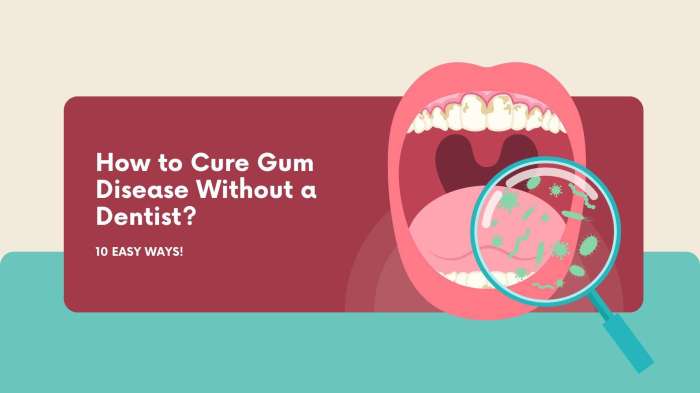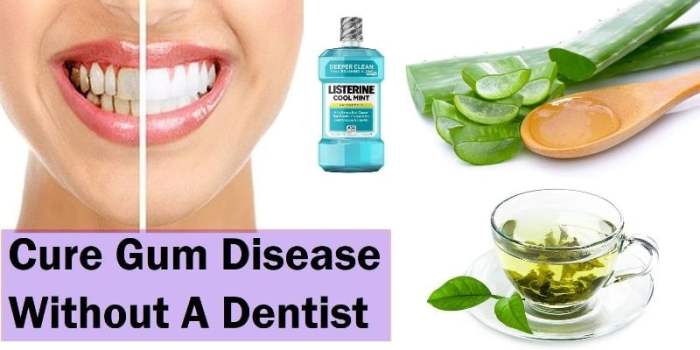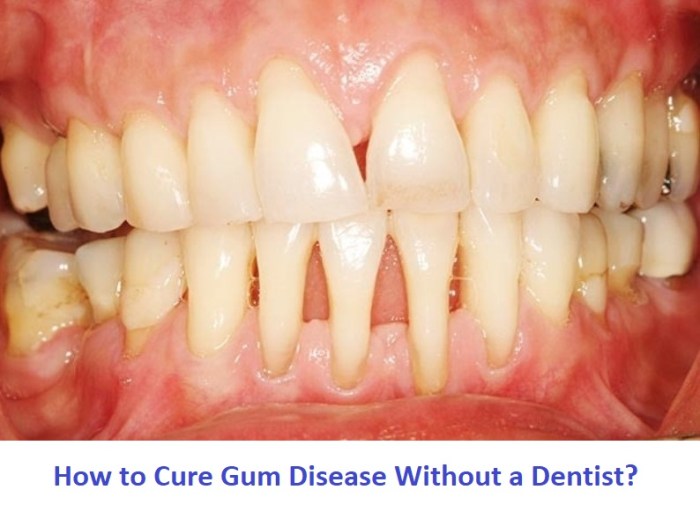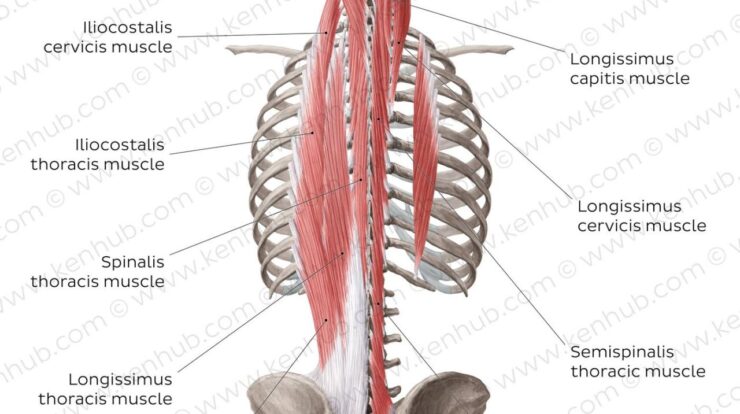
How to cure gum disease without a dentist – Ready to say goodbye to gum disease without the dentist? Buckle up for our deep dive into DIY remedies and expert tips to restore your smile’s radiance. From natural treatments to lifestyle changes, we’ve got you covered. Let’s dive right in and tame those pesky gums!
Gum disease, a common oral ailment, can be a pain in the… gums. But fear not! With a little TLC and the right know-how, you can effectively treat and prevent it from the comfort of your own home. In this comprehensive guide, we’ll arm you with everything you need to know about curing gum disease naturally.
Home Remedies and Natural Treatments

Gum disease is a common problem that can be caused by poor oral hygiene, smoking, or certain medical conditions. While it’s important to see a dentist for regular checkups and cleanings, there are also a number of home remedies and natural treatments that can help to improve gum health and reduce the symptoms of gum disease.
If you’re wondering how to cure gum disease without a dentist, you’re not alone. Gum disease is a common problem, but it can be treated with the right care. There are a number of things you can do to help cure gum disease, including brushing and flossing your teeth regularly, using mouthwash, and eating a healthy diet.
If you’re looking for more information on how to cure gum disease without a dentist, check out this helpful article: how to cure gum disease without a dentist . It provides step-by-step instructions on how to cure gum disease without a dentist, so you can get your smile back on track.
Some of the most effective home remedies for gum disease include:
- Salt water rinse.Gargling with salt water can help to reduce inflammation and kill bacteria in the mouth. To make a salt water rinse, dissolve 1/2 teaspoon of salt in 8 ounces of warm water.
- Baking soda rinse.Baking soda is a natural antibacterial agent that can help to neutralize acids in the mouth and reduce plaque buildup. To make a baking soda rinse, dissolve 1/2 teaspoon of baking soda in 8 ounces of warm water.
- Hydrogen peroxide rinse.Hydrogen peroxide is a powerful antiseptic that can help to kill bacteria and reduce inflammation. To make a hydrogen peroxide rinse, mix 1 part hydrogen peroxide with 2 parts water.
- Tea tree oil rinse.Tea tree oil is a natural antibacterial and antifungal agent that can help to reduce inflammation and kill bacteria in the mouth. To make a tea tree oil rinse, add 2-3 drops of tea tree oil to 8 ounces of warm water.
- Aloe vera gel.Aloe vera gel is a natural anti-inflammatory agent that can help to soothe and heal gum tissue. To use aloe vera gel for gum disease, apply a small amount of gel to the affected area and massage gently.
In addition to these home remedies, there are also a number of natural treatments that can help to improve gum health and reduce the symptoms of gum disease.
- Cranberry extract.Cranberry extract is a natural antibacterial agent that can help to prevent bacteria from adhering to the teeth and gums. Cranberry extract can be taken in supplement form or consumed in cranberry juice.
- Green tea extract.Green tea extract is a powerful antioxidant that can help to reduce inflammation and protect the gums from damage. Green tea extract can be taken in supplement form or consumed in green tea.
- Vitamin C.Vitamin C is an essential nutrient that is important for gum health. Vitamin C helps to strengthen the connective tissue in the gums and protect them from damage. Vitamin C can be taken in supplement form or consumed in citrus fruits and vegetables.
It is important to note that these home remedies and natural treatments are not a substitute for regular dental care. If you have gum disease, it is important to see a dentist for diagnosis and treatment. However, these remedies can help to improve gum health and reduce the symptoms of gum disease.
Oral Hygiene Practices
Maintaining proper oral hygiene is crucial for preventing and treating gum disease. Effective oral hygiene practices include regular brushing, flossing, and using mouthwash to remove plaque and bacteria from the teeth and gums.
Brushing:Use a soft-bristled toothbrush and fluoride toothpaste. Brush at least twice a day, for two minutes each time. Hold the toothbrush at a 45-degree angle to the gum line and gently brush in circular motions. Brush the outer, inner, and chewing surfaces of all teeth.
Flossing:Use dental floss to clean between teeth, where a toothbrush can’t reach. Floss once a day, by gently sliding the floss between each tooth and moving it up and down.
Mouthwash:Use an antiseptic mouthwash to kill bacteria and reduce inflammation. Rinse your mouth with mouthwash for 30 seconds after brushing and flossing.
Other Oral Hygiene Products:Tongue scrapers and water flossers can also be used to improve oral hygiene. Tongue scrapers remove bacteria from the tongue, while water flossers use a stream of water to clean between teeth.
It’s possible to tackle gum disease without a dentist, but it’s important to approach it with care. Natural remedies like salt water rinses and tea tree oil can help reduce inflammation and bacteria. For more in-depth guidance, check out this comprehensive article: How to Cure Gum Disease Without a Dentist . Remember, while these methods can provide relief, they’re not a substitute for professional dental care.
Optimal Oral Hygiene Plan:
- Brush your teeth twice a day with fluoride toothpaste.
- Floss your teeth once a day.
- Use mouthwash after brushing and flossing.
- Consider using a tongue scraper and water flosser.
- Visit your dentist regularly for checkups and cleanings.
Dietary Modifications

Diet plays a crucial role in maintaining gum health. Certain foods and nutrients can help fight gum disease and promote healing. Here’s how dietary modifications can improve gum health:
Anti-inflammatory foods:Consuming foods rich in anti-inflammatory compounds can help reduce inflammation in the gums. These include fruits and vegetables like berries, leafy greens, and tomatoes, as well as omega-3 fatty acids found in fish and flaxseeds.
Nutrient-rich foods
- Vitamin C:Vitamin C is essential for collagen production, which strengthens gum tissue. Citrus fruits, bell peppers, and broccoli are good sources of vitamin C.
- Vitamin D:Vitamin D has anti-inflammatory properties and supports immune function. Fatty fish, eggs, and fortified milk are good sources of vitamin D.
- Calcium:Calcium helps strengthen teeth and bones, including the jawbone that supports the gums. Dairy products, leafy greens, and fortified foods are good sources of calcium.
Foods to limit or avoid
- Sugary foods and drinks:Sugar feeds bacteria that cause plaque and gum disease. Limit sugary snacks, candy, and soda.
- Processed foods:Processed foods are often high in unhealthy fats and low in nutrients. They can contribute to inflammation and gum disease.
- Alcohol:Alcohol can dry out the mouth, reducing saliva flow and increasing the risk of gum disease.
Sample meal plan
Here’s a sample meal plan that incorporates foods that support gum health:
- Breakfast:Oatmeal with berries and nuts
- Lunch:Grilled salmon salad with leafy greens and citrus fruit
- Dinner:Chicken stir-fry with brown rice and broccoli
- Snacks:Apple slices with peanut butter, carrot sticks with hummus
By incorporating these dietary recommendations into your routine, you can help improve gum health and reduce the risk of gum disease.
Alternative Therapies: How To Cure Gum Disease Without A Dentist
In addition to conventional dental treatments, alternative therapies offer potential benefits for treating gum disease. These therapies aim to stimulate the body’s natural healing mechanisms and address underlying causes of the disease.
Acupuncture
Acupuncture involves the insertion of thin needles into specific points on the body. It is believed to regulate energy flow, reduce inflammation, and enhance immune function, which may benefit gum health.
Gum disease can be a pain, but it doesn’t have to be. There are plenty of ways to cure gum disease without a dentist. For instance, you can try this simple home remedy: mix equal parts hydrogen peroxide and water, and rinse your mouth with it twice a day.
Gum disease can be a pain, but it doesn’t have to be. You can cure gum disease without a dentist.
Case Study:A study published in the Journal of Periodontal Research found that acupuncture reduced bleeding and inflammation in patients with chronic periodontitis.
Herbal Remedies, How to cure gum disease without a dentist
Certain herbs possess anti-inflammatory and antibacterial properties that may aid in gum disease treatment. These include:
- Turmeric: Contains curcumin, a potent anti-inflammatory agent
- Green tea: Rich in antioxidants and polyphenols that fight bacteria and reduce inflammation
- Myrrh: An antimicrobial and astringent that helps tighten gums and reduce bleeding
Ozone Therapy
Ozone therapy involves administering ozone gas to the affected area. Ozone has antibacterial and anti-inflammatory properties, and it may help kill bacteria and promote healing.
Anecdotal Evidence:Many dentists and patients report positive results using ozone therapy for gum disease. However, more research is needed to fully evaluate its effectiveness.
Warning Signs and When to Seek Professional Help

Gum disease is a prevalent oral health issue that can range from mild to severe. Understanding the common warning signs and knowing when to seek professional help is crucial for maintaining optimal oral health. This section will highlight the telltale symptoms of gum disease and provide guidance on when it is essential to consult a dental professional for proper treatment.
If you’re looking for a way to cure gum disease without a dentist, you’re in luck. There are a number of natural remedies that can help to improve your oral health. One of the most effective is oil pulling. This involves swishing a tablespoon of coconut oil around your mouth for 15-20 minutes.
The oil will help to remove bacteria and plaque from your teeth and gums. For more tips on how to cure gum disease without a dentist, click here .
Recognizing the Warning Signs
The early stages of gum disease often go unnoticed, making it vital to be aware of the subtle signs that may indicate its presence. These warning signs include:
- Red, swollen, or bleeding gums
- Receding gums
- Loose or shifting teeth
- Persistent bad breath or a metallic taste in the mouth
- Pus between teeth and gums
When to Seek Professional Help
If you experience any of the warning signs mentioned above, it is essential to seek professional dental care promptly. Delaying treatment can lead to the progression of gum disease, potentially resulting in more severe complications. Here are some indications that professional help is necessary:
- Persistent symptoms that do not improve with home remedies
- Severe pain or discomfort
- Loose teeth that interfere with eating or speaking
- Pus or bleeding that does not subside
- Receding gums that expose tooth roots
Early detection and prompt treatment are crucial for effectively managing gum disease. By being mindful of the warning signs and seeking professional help when necessary, you can preserve your oral health and prevent the development of more serious complications.
Final Thoughts
Conquering gum disease without a dentist is entirely possible with the right knowledge and a little patience. Remember, consistency is key. By incorporating these remedies and practices into your daily routine, you’ll be well on your way to a healthier, brighter smile.
So, let’s make gum disease a thing of the past and embrace a confident, pain-free smile!
FAQ Guide
Can I use baking soda to treat gum disease?
Yes, baking soda is a natural antibacterial and anti-inflammatory agent. Mixing it with water to form a paste and applying it to the affected area can help reduce inflammation and kill bacteria.
How often should I brush my teeth to prevent gum disease?
Brush your teeth at least twice a day, for a minimum of two minutes each time. Use a soft-bristled toothbrush and fluoride toothpaste to remove plaque and bacteria effectively.
What foods should I avoid if I have gum disease?
Sugary foods, processed snacks, and sticky candies can feed the bacteria in your mouth and worsen gum disease. Opt for a balanced diet rich in fruits, vegetables, and whole grains instead.





